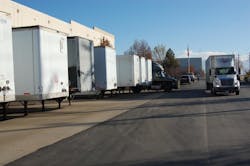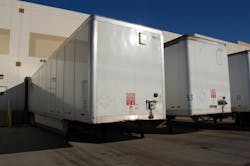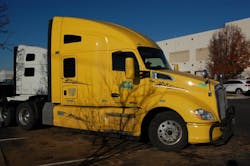So what are some of the broader transportation trends trucking CEOs should keep their eyes on as we hurdle into 2017 and beyond?
For example, how will domestic migration patterns affect freight flows? Will the increasing automation of just about everything lead to job losses in the freight industry as well as the global economy as a whole? Could transportation infrastructure investments and rising energy “self-sufficiency” in the U.S. prime the country for big economic growth?
These aren’t $64,000 questions, mind you; they are more like 64 billion-dollar questions, with huge ramifications for trucking – especially in terms of how freight gets moved.
John Larkin, managing director and head of transportation capital markets research for Stifel Capital Markets, recently took a stab at identifying some of the big long-term freight market trends, while providing a few near-term insights as well – with both sets offering more than a few interesting things for trucking firms to contemplate.
“We remain very bullish, with respect to transportation and logistics stocks, over the long term,” Larkin said in a research note.
“However, we think that near term fundamentals are generally weaker than widely understood. Rate pressures building throughout 2016 will not reverse on a dime [and] some inventory overhang still appears to exist throughout our nation’s supply chains,” he stressed.
“These and other factors cause us to believe that freight transportation and logistics fundamentals won’t definitively turn positive until mid-year 2017, at the earliest,” Larkin pointed out. “And, it is entirely possible, in our view, that the turnaround won’t become evident until the second quarter of 2018.”
That being said, there are ten key long-term trends he believes are poised to accelerate in the coming year or so; ones freight companies – truckers included – need to keep an eye on.
The pro-business stance of the Trump presidency: “We sense that the widespread business optimism regarding the future, following the election of Donald J. Trump to the U.S. Presidency, will drive accelerated hiring and increased levels of capital investment in the coming years, even without any additional fiscal policy stimulus,” Larkin said.
“Pro-business policies will help move the economy forward, even more so. For example, a streamlined/rationalized federal tax code should directly increase corporate cash flows, allow for the repatriation of foreign profits, while stimulating growth and investment,” he added.
“Fewer and less onerous environmental, labor, and energy development related regulations should also provide a much needed incremental boost for the broader economy,” Larkin pointed out.
Furthermore, a sensible infrastructure investment plan and the rebuilding and modernization of our nation’s military should also contribute to an accelerating rate of economic growth, he noted.
“Lastly, revised trade policy should favor exports and somewhat discourage imports, thereby favoring domestic manufacturing,” Larkin stressed, “The sum total of all these initiatives has the potential to significantly ramp up the rate of demand growth for freight transportation and logistics services.”
Amazon’s freight transport plans and the e-commerce wars: Amazon’s entire infrastructure network is geared for speed and in the case where strategic logistics partners are not up to the challenge, it’s beginning to provide transportation and logistics services itself, Larkin noted.
“Just in the past year or two, the company has rolled out its own trailer fleet, has developed an uber-like last mile delivery process named Flex, has received its license to operate as a non-vessel owning common carrier (NVOCC) in the international container shipper market, has developed its own air parcel hubs with its ‘own’ dedicated aircraft, has been at work developing its own truck brokerage operation, and recently revealed a plan to deliver packages by drone from airborne warehouses,” he said.
“All of this activity doesn’t even speak to the 20 or so new distribution centers and fulfillment centers the company has constructed in 2016 in the U.S., not to mention around the world,” Larkin added.“While the company builds out its network and its network freight density and potentially an insurmountable lead in the e-commerce space, carriers and 3PLs [third party logistics providers] alike must develop an Amazon strategy,” he stressed. “Either engage in a fully-integrated, collaborative partnership with Amazon, or align with more traditional, slower moving customers. It may well prove difficult to serve both of these ‘masters’ sustainably.”
Automation and its impact on manufacturing, transportation, and especially jobs: Automation of manufacturing could actually speed up “reshoring” efforts and the implication for transportation is “dramatic,” Larkin said.
“Freight will be touched domestically eight to 12 times when a product is produced entirely within a continent or a country rather than the two to three times it will be touched within the consuming continent or country when a product is produced overseas and imported,” he explained.
“With automated production eliminating the labor cost differential, which historically justified globalized supply chains, raw materials, semi-finished materials, finished materials, parts, components, sub-assemblies, and finished products will all require transportation in and around the region of consumption,” Larkin pointed out.
“Lastly, 3D printing is the ultimate in automated manufacturing as the component, part, sub-assembly, or finished product can be produced with minimal notice in the vicinity of the end user,” he said. “Opportunities for the transportation of various substrates to the 3D printing enabled front line production sites should abound.”
Automating transportation, though, comes with more challenges – and, if successful, may reduce jobs in this sector, Larkin emphasized; though in light of the current driver shortage that might be a net positive, he thinks.“Robust autonomous technology [need to be] capable of dealing with variable weather conditions, invisible lane markings, hackers, communication system disruptions, etc.,” Larkin explained. “Taken alone, autonomous trucks operating on the interstate highway system would likely eliminate the persistently challenging driver shortage and might destroy highway-to-rail intermodal conversion economics.”
Taken together with double 53-ft. trailers, triple 28-ft. trailers, platooning, and/or other highly productive vehicle combinations and technologies, autonomous trucks could be the “next transformational driver” leading to a sizable reduction in the ratio of logistics costs to gross domestic product, Larkin said.
In spite of the automation trend, the mismatch between available labor and available jobs widens: “The U.S. needs to overhaul its education system, in our view, as automated manufacturing and 3D printing won’t create the traditional manufacturing jobs often promised by politicians,” Larkin emphasized.
“We essentially need to stop suggesting that all citizens receive a college diploma while developing and providing an alternate educational path that equips a sufficient number of young people with the skills necessary to program a computerized machine tool, maintain a robotic welding machine, re-optimize an automated warehouse, operate a platoon of trucks, etc.,” he stressed. “When will our political leaders wake up and recognize the need for this new wave blue collar educational path? Or will automation lead to increased unemployment, a smaller workforce, and all the attendant social problems?”
Dynamic pricing, long a staple in the airline industry, is coming to the world of freight: With the advent of Application Program Interfaces (APIs) real-time data can be exchanged between 3PL’s, freight brokers, carriers, shippers, and receivers – and this real-time data interchange, combined with predictive analytics, can enable motor carriers to achieve better lane balance, higher equipment utilization rates, and higher load factors, Larkin believes.
“By offering real time, variable pricing strategies and tactics, designed to fill up a truck or a train that will be running next Wednesday anyway to meet customer’s requiring time definite service, carriers can run more productive, more balanced, more heavily utilized networks, while maximizing profit potential,” he said.“We expect to see this technique applied in the less-than-truckload sector first. Truckload carriers will likely follow, while the railroads may be last to adopt this approach,” Larkin noted.
Migration to the south, the southwest, and the mountain states will continue: “The states that continue to ramp up taxes and regulations are losing population or, at a minimum, not growing as fast as the states that have adopted more business-friendly tax and regulatory regimens,” Larkin explained.
“Freight flows are adjusting to the changing industrial migration and population migration patterns,” he cautioned. “[So motor] carriers with a focus on hauling manufactured products out of certain regions (i.e., the northeast, for example) need to be cognizant of these accelerating trends in order to maintain the equipment utilization and lane balance that often drives profitability.”
Urbanization is changing the way Americans live, work, and play. And that impacts freight: While the suburbs “aren’t completely dying,” Larkin warned that Millennials and “empty nesters,” in increasing numbers, seem to want to live, work, and play in urban areas.
“Many of those preferring the urban habitat choose not to own an automobile, instead preferring public transit, walking, cycling, or ride sharing,” he said. “Shopping is often done online and desired food, beverages, other consumer goods, as well as, durable goods are delivered directly to the buyer’s residence or place of employment.”
Thus motor carriers whose entire existence tends to revolve around the more traditional “brick and mortar” supply chains need to be aware of the speed with which this urbanization trend is contributing to rapidly changing consumer preferences.
“Only Amazon and Amazon’s partners seem to be ahead of the power curve as this powerful dynamic reshapes America’s supply chains, particularly the last mile delivery component of retail supply chains,” he emphasized.
Infrastructure investment is critical to improving the nation’s transportation network. But funding mechanisms need change: The U.S. network of highways, developed in the 1950s, was largely federally funded and paid for by highway users taxes collected in“Some have argued for a vehicle miles traveled (VMT) tax as substitute for the fuel tax, but Congress seems unable to advance that concept,” he noted. “The VMT tax would not suffer from improved fuel economy, but might prove more challenging to efficiently collect.”
Yet President-elect Trump is proposing a trillion dollar, multi-year infrastructure program that would address deficiencies in the U.S. highway network and that would also address other forms of infrastructure inadequacies, found within public facilities such as ports, intermodal connectors, inland waterways, sewer systems, water distribution, etc.
“Finding funding for such a large scale plan has always been a challenge in Washington D.C.,” Larkin pointed out. “But ramifications for transportation companies would be positive.”
On the one hand, materials used in the construction or rehabilitation of infrastructure would have to be transported, he said. Certain types of carriers – railroads and flatbed-based truckload carriers, in particular – would be beneficiaries, Larkin added.
“And to the extent traffic congestion were to be eliminated and network fluidity were to be enhanced, transportation companies would be able to increase asset utilization, in some cases fairly dramatically,” he noted.
U.S. energy self-sufficiency will drive an improved trade balance and freight demand: With the advent of hydraulic fracturing and horizontal drilling, the U.S. has the potential to become energy self-sufficient within the next five to 10 years – and the exploration and energy extraction processes alone should generate significant amounts of freight and incremental economic activity, Larkin stressed.
“The potential for a resurgence in oil and natural gas liquids transportation demand, frack-sand transportation demand, and demand for the transportation of other goods and products needed by crews conducting the exploration and extraction operations certainly exists over the coming one to two year time frame,” he said.
“And with our low cost energy position enhanced, the potential for further growth of the feedstock intensive petrochemical industry also exists and could drive additional transportation demand,” Larkin noted. “Railroads, liquid bulk barge operators, and tank truck carriers should stand to benefit if and when this trend gains momentum once again.”
The U.S. still needs a national freight strategy: A “national freight strategy” is still required in order for the U.S. to do “more with less” and accelerate the rate of what Larkin calls “secular” economic growth.
“The U.S. has never developed and implemented a full blown national freight transportation strategy,” he said. “As a result, our multi-modal network is sub-optimized. The lack of a comprehensive plan also ensures that the importance of intermodal connectors, ports, inland waterways, railroads, etc., is ignored.”
Yet Larkin noted that It will be “interesting” to see if Elaine Chao, President-elect Trump’s Secretary of Transportation candidate, will be able to lead the charge in this area “finally addressing our transportation infrastructure deficit, our outdated revenue generation mechanism for transportation infrastructure projects, and our lack of a cohesive national freight transportation strategy.”
Larkin thinks that, “If she is successful,” Chao will give the U.S. economy and the freight transportation industry much needed “shots in the arm.” And a national freight strategy would not only lead to a more efficient allocation of capital to the highest return projects but would “contribute to America’s improved global competitiveness,” he added.





